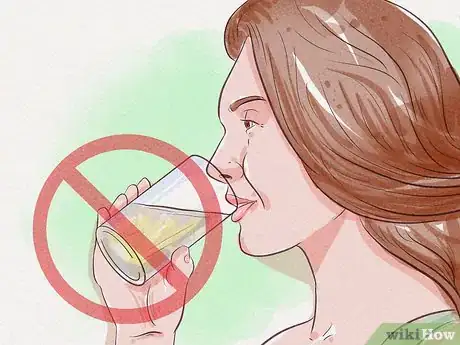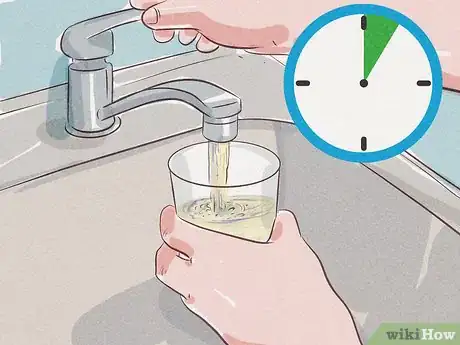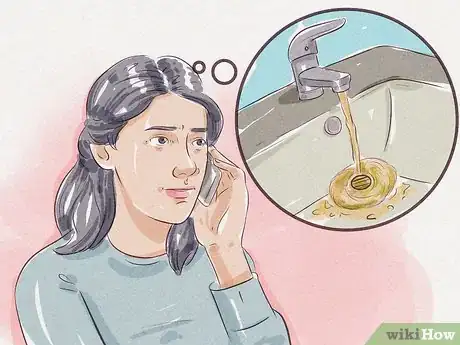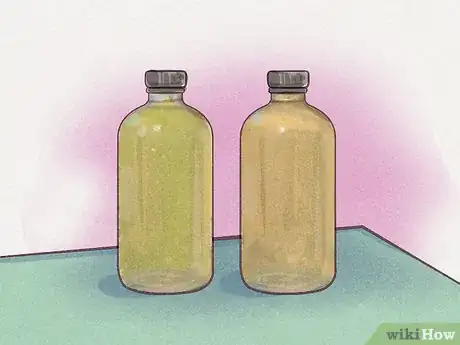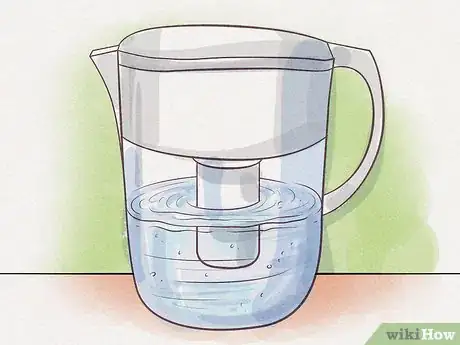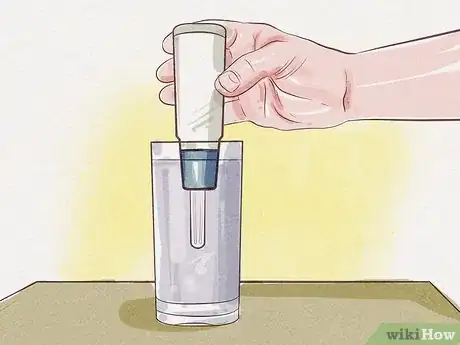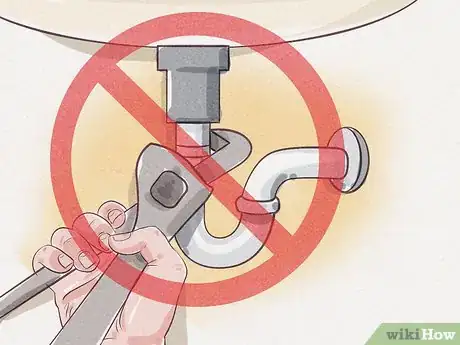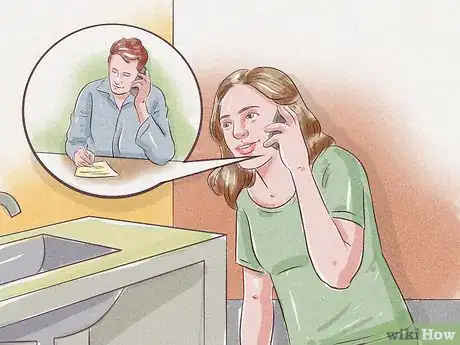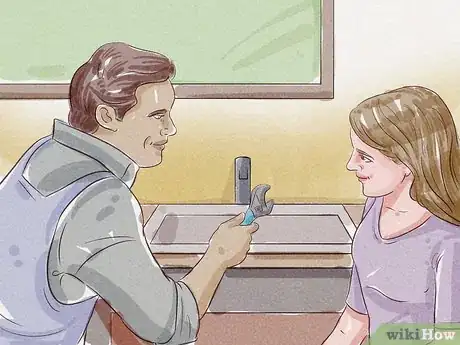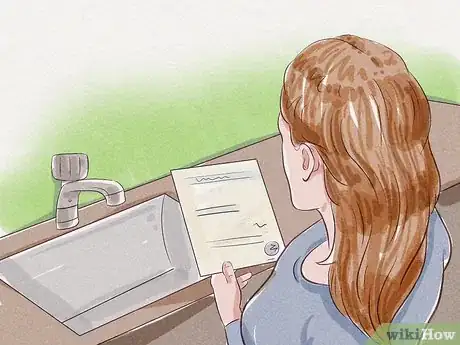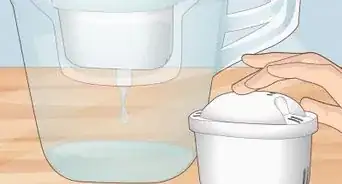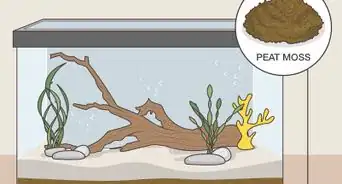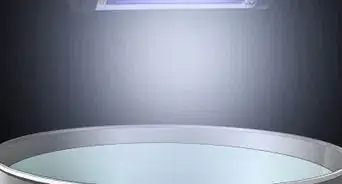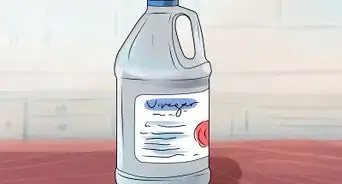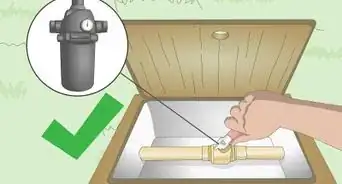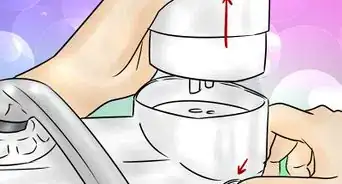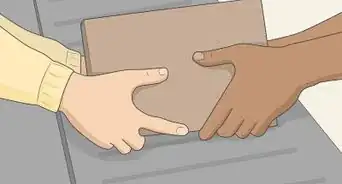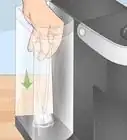This article was co-authored by wikiHow Staff. Our trained team of editors and researchers validate articles for accuracy and comprehensiveness. wikiHow's Content Management Team carefully monitors the work from our editorial staff to ensure that each article is backed by trusted research and meets our high quality standards.
There are 7 references cited in this article, which can be found at the bottom of the page.
This article has been viewed 164,268 times.
Learn more...
If you notice yellow discoloration in your tap water, you may worry about whether it is safe to drink and how to fix the problem. In most cases, however, yellow water is both harmless and easy to treat. Deciding whether your water provider or your internal plumbing has turned the water yellow is the first step to take. Then, once you've found the cause, hire a professional to help you decide on the best treatment option.
Steps
Determining the Cause
-
1Avoid using the tap water until you determine a cause. Although water discoloration can be harmless, your safest option is to stop drinking it until you know what turned it yellow. Until you're certain what the cause is, drink bottled water and avoid cooking or washing with the tap water.
-
2Turn on your sink for several minutes to see if the water turns clear. If the water clears out after several minutes, the issue is likely with your house plumbing. You will need to contact a plumber to determine an exact cause. If it does not, however, and remains yellow, it is probably an issue with your city's mainline.
- If the water does turn clear, you should still avoid drinking, cooking, or washing with it until you know what the problem is.
Advertisement -
3Ask your neighbors if they have noticed any changes in their tap water. This can help you evaluate the extent of the problem. If your neighbors have also noticed discoloration in their water, then the issue probably reaches beyond your home. If your neighbors' water has not turned yellow, however, the issue will likely need to be investigated by a plumber.[1]
- To determine the extent of the water discoloration, you might try asking neighbors who live further away from your home or even people from a different, nearby neighborhood.
-
4Call your water provider to ask about any citywide problems. If the water discoloration does not seem to be strictly within your home, it may be caused by pipeline sediments in the water main. Contact your water provider immediately to ask about the cause and whether your household should drink bottled water until the problem is fixed.[2]
- Ask if your water provider has recently changed their source, as this could be the cause of yellow water.[3]
-
5Check to see whether you live near marshlands. If you recently moved to a new home and the water is yellow, the coloration may be harmless if you live in an area with lots of marshlands. As water moves through peat soils and is filtered, it usually retains a yellowish color. Although unpleasant looking, yellow water that was initially in marshes is harmless.[4]
- In the United States, these conditions usually occur in the Southeast, Northwest, New England, and Great Lakes regions.
-
6Distinguish between yellow or greenish water. While yellow water is often harmless to drink, greenish or greenish-blue water usually indicates that the copper piping in your home has corroded. Contact a plumber immediately and switch to bottled water until you can pinpoint and fix the cause.[5]
- Drinking water with copper corrosion can cause vomiting and gastrointestinal distress.
Filtering Your Water
-
1Try filtering your water if the problem exists beyond your home. If you live near marshlands or your city is experiencing a pipeline sediment issue, you may want to filter your water. Contact your water supplier to make sure it is safe to drink. If so and you want to fix the discoloration, a filtration system can help clear your water.
- You can purchase a filtration system from most home improvement stores.
-
2Ask a professional about which filtration system would best fit your needs. Consulting a plumber or water quality expert can help you find a system that is easily installable and can get rid of the source of your discoloration. Before you buy a system, ask one or several professionals for their opinion.[6]
-
3Install a water filter if you are primarily concerned about sediment. Most water filters are equipped to remove sediment, debris, and some bacteria from the water. They generally do not, however, eliminate viruses. If you know that the cause is primarily sediment from rust or peat moss, a water filter may solve the problem.
- Water filters with a charcoal element in their cartridges can remove unpleasant tastes, if this is an issue with your water.
-
4Choose a purifier to sterilize your water. Water purifiers use UV lights or chemicals to eliminate any pathogens, viruses, sediments, or debris that might naturally be found in the water. The main downside to purifiers, however, is that they can leave an unpleasant taste or odor in your water.[7]
- If your main concern about your discolored water is its taste or odor, you may want to choose a different filtration system.
Replacing Rusty Plumbing
-
1Do not attempt to replace rusty plumbing unless you have experience. Fixing or removing rusty plumbing is usually too dangerous for the amateur plumber. Unless you are a professional plumber or have experience working on interior pine lines, avoid DIYing a potential plumbing issue.[8]
- Fixing rusty plumbing by yourself can result in serious injuries to yourself or damage to your home.
- Although fixing rusty plumbing on your own may seem like it will save money, you may end up worsening the problem and costing you more in the long term.
-
2Call a professional to find the cause of your water discoloration. A plumber can find the issue with your interior plumbing and assess the best method to fix it. If you have determined that the water discoloration is not caused by a mainline problem, contact a plumber.
- While searching for local plumbers online, check their company's reviews. Avoid companies with many negative reviews, as a bad plumber can cause even more damage to your home.
-
3Solicit the opinion of several plumbers for a more rounded opinion. Contact at least 2 or 3 plumbers for a house inspection before choosing an option. You'll be able to get more perspectives on the cause of your water discoloration and the best, most cost-efficient way to treat the problem.
- The cheapest option is not necessarily the best choice, when it comes to plumbing. Choose the plumber who has the most experience and can offer references or positive reviews from their previous clients.
-
4Review your home warranty to check if plumbing issues are covered. Depending on the cause and suggested fix, rusty or corroded plumbing may be covered by your warranty. Contact your insurance company after you have pinpointed the cause to determine what the out-of-pocket cost for repair will be.[9]
- If you don't currently have a copy of your home warranty, contact your insurance or home warranty company. As their client, you should be entitled to a new copy.
Community Q&A
-
QuestionCan water softeners turn water yellow?
 wikiHow Staff EditorThis answer was written by one of our trained team of researchers who validated it for accuracy and comprehensiveness.
wikiHow Staff EditorThis answer was written by one of our trained team of researchers who validated it for accuracy and comprehensiveness.
Staff Answer wikiHow Staff EditorStaff AnswerNew resin in a water softener can turn your water yellow, but this discoloration should rinse out quickly. Your water might also turn yellow if any material was dislodged in the pipes during the installation of the water softener system.
wikiHow Staff EditorStaff AnswerNew resin in a water softener can turn your water yellow, but this discoloration should rinse out quickly. Your water might also turn yellow if any material was dislodged in the pipes during the installation of the water softener system. -
QuestionIs it safe to drink discolored water?
 wikiHow Staff EditorThis answer was written by one of our trained team of researchers who validated it for accuracy and comprehensiveness.
wikiHow Staff EditorThis answer was written by one of our trained team of researchers who validated it for accuracy and comprehensiveness.
Staff Answer wikiHow Staff EditorStaff AnswerIf your water is discolored by iron or manganese, it is safe to drink. However, some other sources of discoloration, such as copper, can be unsafe. It’s best not to drink discolored water until you know what’s causing the issue.
wikiHow Staff EditorStaff AnswerIf your water is discolored by iron or manganese, it is safe to drink. However, some other sources of discoloration, such as copper, can be unsafe. It’s best not to drink discolored water until you know what’s causing the issue. -
QuestionWhat does it mean if my tap water turns yellow after a rainstorm?
 wikiHow Staff EditorThis answer was written by one of our trained team of researchers who validated it for accuracy and comprehensiveness.
wikiHow Staff EditorThis answer was written by one of our trained team of researchers who validated it for accuracy and comprehensiveness.
Staff Answer wikiHow Staff EditorStaff AnswerThis can happen if you’re on well water when rainwater seeps into your well, bringing dirt and other contaminants with it. Don’t drink discolored well water after a rainstorm until you’ve had the water analyzed and figured out the source of the problem. It could contain dangerous bacteria or chemicals.
wikiHow Staff EditorStaff AnswerThis can happen if you’re on well water when rainwater seeps into your well, bringing dirt and other contaminants with it. Don’t drink discolored well water after a rainstorm until you’ve had the water analyzed and figured out the source of the problem. It could contain dangerous bacteria or chemicals.
References
- ↑ https://www.ewg.org/enviroblog/2016/03/five-reasons-your-tap-water-changed-color#.WmVWZtWnHrc
- ↑ https://www.ewg.org/enviroblog/2016/03/five-reasons-your-tap-water-changed-color#.WmVWZtWnHrc
- ↑ https://www.ewg.org/enviroblog/2016/03/five-reasons-your-tap-water-changed-color#.WmVWZtWnHrc
- ↑ http://extoxnet.orst.edu/faqs/safedrink/colors.htm
- ↑ http://extoxnet.orst.edu/faqs/safedrink/colors.htm
- ↑ http://www.berkeleywellness.com/healthy-eating/food-safety/article/rusty-water
- ↑ http://www.waterpurifier.org/ultraviolet-water-purifiers/
- ↑ http://www.permitsprotect.info/plumbing.html
- ↑ http://www.popularmechanics.com/home/how-to/a8829/how-to-get-the-most-from-your-home-warranty-15367939/
About This Article
If you notice yellow water coming from your tap, avoid drinking it until you figure out the cause. You may need to contact a plumber or your local water provider to find out whether the problem is in your home or citywide. If the issue is citywide, it may be enough to install a water filter in your home. You can also use a purifier if you have concerns about whether the water is safe to drink. For yellow water caused by problems with the plumbing in your home, such as rusty pipes, you’ll probably need to bring in an expert. Reach out to a reputable plumber in your area and ask them to help you find and fix the source of the problem. For more tips on filtering water and replacing old plumbing, keep reading!
